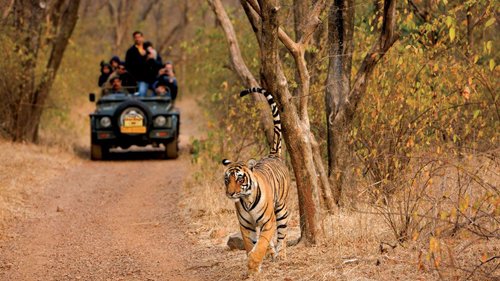GENERAL INFORMATION
| Area | 392 Sq km. | |
| Altitude | 505 Meters | |
| Best season | October – March | |
| Languages | English, Hindi, Rajasthani | |
| Climate | Max | Min |
| Summer | 37°c | 23°c |
| Winter | 29°c | 9°c |
| Clothing | Summer | Winter |
| Light tropical | Woollen |
TOURIST PLACES
RANTHAMBORE NATIONAL PARK
 Overlooking the Ranthambhore fort is the Ranthambore National Park in a picturesque valley. The wildlife reserve of Ranthambore is amongst the notable national parks that India boasts. Wildlife viewing opportunities are in plenitude here. With extensive flora and fauna varieties, the park is the immensely loved amongst travelers and tourists.
Overlooking the Ranthambhore fort is the Ranthambore National Park in a picturesque valley. The wildlife reserve of Ranthambore is amongst the notable national parks that India boasts. Wildlife viewing opportunities are in plenitude here. With extensive flora and fauna varieties, the park is the immensely loved amongst travelers and tourists.
Sprawling dry deciduous, forest and woodland ranges of Dhok in Ranthambore are known for its tigers. Numbering more than 28, an experience with this predator is not uncommon here. Conspicuous prey species of tiger here incorporate sambar, cheetal (Spotted Deer), nilgai (Blue Bull), wild-hog, Chinkara (Indian Gazelle) and langur. Interestingly, the peafowl likewise forms a noteworthy menu item of this enormous cat. Tranquil waters of three lakes- Raj bagh, Padam Talab, and Milak Talab-in the Park entice an extensive number of migratory and neighborhood birds. Furthermore, these lakes make accessible supple nutritive sustenance for the sambar who promptly takes to the water for bolstering. What’s more, it’s treating to eyes when you observe freshwater crocodiles lounging in the winter sun for controlling their body temperature.
In spite of the fact that leopard is a co-predator of the tiger, yet stays away from it. Hyena and jackal are its camp supporters. The reserve additionally harbors a little populace of sloth bear and python.
For going around the park, jeeps are accessible on hire.
JOGI MAHAL
Above one of the hills is the deliberately and strategically built tenth century fort, the Ranthambore Fort. Inside of this fortress are some stupendous landmarks. The landscape has some lofty rough rocks bordering the lakes, rivers and waterways, encompassed by dense forest and thick shrubberies.
The woods have deciduous sorts of trees with Dhok as the most conspicuous tree. At the foot of the post begins the woods. Situated here is the Jogi Mahal, which houses the second biggest banyan tree in India. Tigers meander around the lakes, Padam Talab, the Raj Bagh Talab and the Milak Talab that this woods houses. The woods show the old time escarpments and overflows of Ranthambore, scattered all through the backwoods, symbolizing the region’s glorious past.
The tigers visit these remnants as well. Ranthambore serves as the best stop for wildlife photography and draws in experts from all around the globe. All prise to the sincere efforts of Project Tiger, tigers can be spotted easily, lazing around in the sun, or hunting excitedly with extraordinary energy close to the sambar lake. No other sanctuary gives such an amazing view of tigers in broad daylight, with no attempt at being subtle. Panthers are likewise a part of this woods, yet are mostly found on the outskirts of the wildlife park, primarily at Kachida valley. This is because of their unavoidable fights with the tigers here. Sambars, which are in an extensive number here, are the principle prey for the predators. Swamp crocodiles, hyenas, jungle cats, sloth bears, chital, nilgai and chinkara are additional occupants of this forest. Dark storks, quails, Bonelli’s hawks, spur fowls, peaked serpent falcons and painted storks is the avifauna of the forest. Numerous birds, particularly an assortment of ducks migrate to this park as winters approach.
HOW TO GET THERE
By Air – Jaipur 165 km is the nearest airport
By Rail – Ranthambhor National Park is about 12 km away from the Sawai Madhopur Railway Station.
By Road – Ranthambhor is connected by road with the major cities of India. Some important distances are
|
DISTANCE
|
Delhi
|
Agra
|
Jaipur
|
Udaipur
|
Ajmer
|
|
RANAKPUR
|
404 km
|
265 km
|
182 km
|
437 Km
|
256 Km
|
